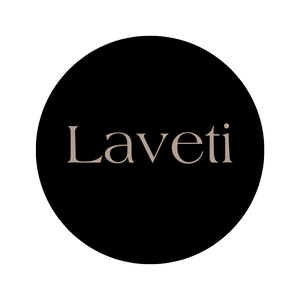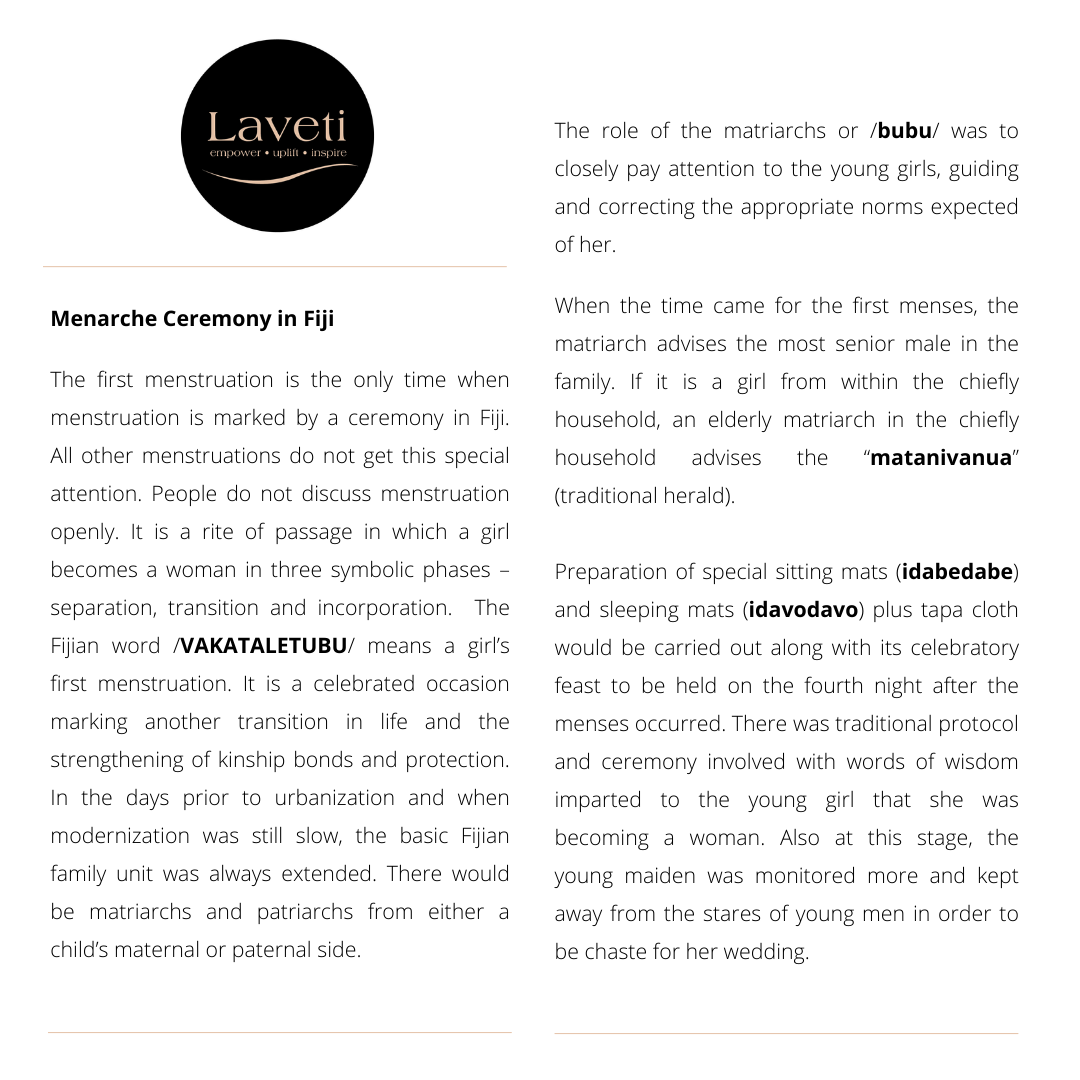Menarche Ceremony in Fiji
The first menstruation is the only time when menstruation is marked by a ceremony in Fiji. All other menstruations do not get this special attention. People do not discuss menstruation openly. It is a rite of passage in which a girl becomes a woman in three symbolic phases – separation, transition and incorporation. The Fijian word /VAKATALETUBU/ means a girl’s first menstruation. It is a celebrated occasion marking another transition in life and the strengthening of kinship bonds and protection. In the days prior to urbanization and when modernization was still slow, the basic Fijian family unit was always extended. There would be matriarchs and patriarchs from either a child’s maternal or paternal side. The role of the matriarchs or /bubu/ was to closely pay attention to the young girls, guiding and correcting her the appropriate norms of her.
When the time came for the first menses, the matriarch advises the most senior male in the family. If is a girl from within the chiefly household, an elderly matriarch in the chiefly houosehold advises the matanivanua (traditional herald).
Preparation of special sitting mats (idabedabe) and sleeping mats (idavodavo) plus tapa cloth would be carried out along with its celebratory feast to be held on the fourth night after the menses occurred. There was traditional protocol and ceremony involved with words of wisdom imparted to the young girl that she was becoming a woman. This was the stage too the young maiden was monitored more and kept away from the stares of young men in order to be chaste for her wedding.
Prior to the four nights celebratory feast, the young girl’s welfare is looked after by her maternal relatives. These included the new cleanliness and hygiene for the girl to learn. Prior to modern sanitary pads, the Fijian women of old used soft white tapa. The used tapa was never burned. They were always buried in always secretly because a young girl’s first menses was believed to be very potent and could be misused by a person practicing Witcraft. All the while the young girl was confined indoors during in the first 3 days of since her menses occurred.
On the fourth day, the day of the celebratory feast, the young maiden was taken out to the river or sea to bathe (sili). As expected, there was the usual retinue of women accompanying her and this was always a jovial occasion.
In some parts of Fiji, the girl’s paternal side prepared the masi costume to be worn from the residence to the bathing area. The costume was discarded at the bathing area and is intended to be gifted to the matriarchs who have been attending to her during her confinement.
The river or sea where the bathing occurred was rendered tabu afterwards. The tabu was intended to allow replenishing of the area in readiness for her wedding feast whenever it occurred.
When the maiden emerged from bathing, her maternal relatives wait for her with new masi attire. Wearing the new costume, she takes her place on the freshly arranged sitting mats (idabedabe). Protocols that follow include presentation of a whale tooth from the girl’s paternal side. The recipient of the whale tooth is the girl’s maternal uncles or grandparents. The purpose behind the whale tooth is to solemnly ask the young maiden’s maternal kin for their protection and custodianship. This ceremony underscored the high esteem placed in one’s vasu or maternal relatives for traditional holds that one’s life originated with one’s mother. Therefore, one’s mother and all maternal relatives are sacred.
The girl gradually learns about matters related to her new female gender identity. The menarche ceremony on the other hand, is a rite of passage whereby everything that she has to learn in the course of years is explained to her and emphasized on that special, specific moment. Her new female gender identity has become more complex because she has to interact with more people expressing different identities towards them. She has to negotiate between her individual identity, which does not change much in daily life, and her collective identity to which new and more gender expectations and roles are attached now. The next symbolic step to adulthood she will take when she has stepped over the threshold of her new house. This is when she will be married and will be living with her husband in their own house. This is when her daily life changes severely. When she has given birth to her first child, she will finally be regarded as an adult woman. In the past there was another indicator of womanhood before a marriage and childbirth. This was the practice of tattooing the girl who has had her first menstrual period.
During the ceremony at a girl’s first menstruation, she has intense contact with her female relatives. This strengthens bonds between them. She will receive many gifts. The time she spends with her relatives will be the greatest gift; not only for her but also for the people she spends time with, especially the women. This is the first time in her life where she realizes she is the focus of attention because of what has happened to her personally. It is not only a significant event to her but also for her relatives. By telling the girl how she is supposed to subsequently behave and what will await her in the future, the women explain to her how a woman should behave and how a woman will be a woman. This is where the importance of the menarche ceremony lies.
Source: Simione Sevudredre
Young Fijian girls in traditional occasions of celebration







